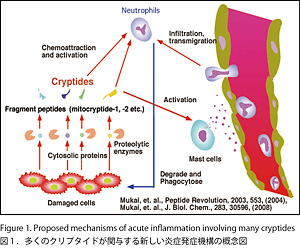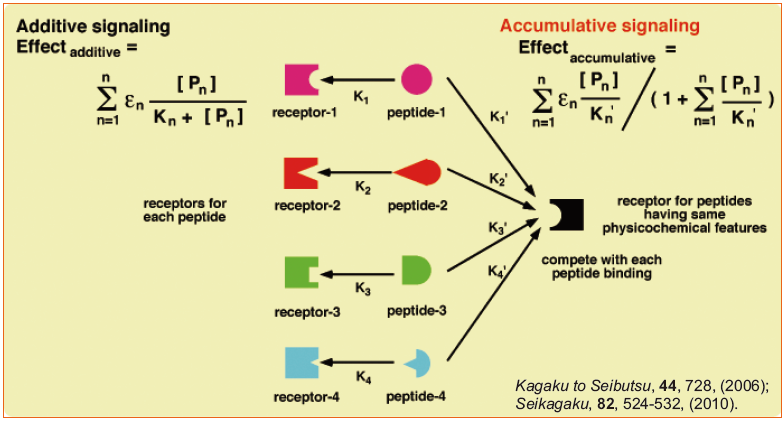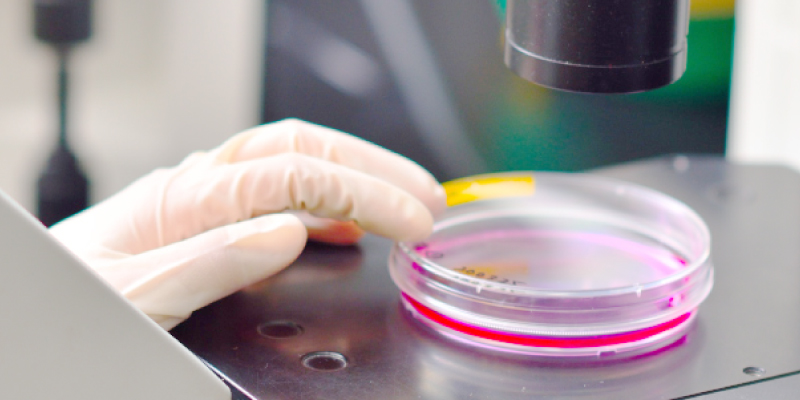メディカルバイオサイエンス学科
 向井 秀仁(むかい・ひでひと)
向井 秀仁(むかい・ひでひと)
Hidehito Mukai
専門分野/ペプチド科学、細胞生物化学、創薬科学
研究キーワード/生理活性ペプチド、クリプタイド
職位:教授
学位:学術博士(筑波大学)
- 筑波大学大学院博士課程生物工学学際プログラム修了
- テキサス大学 JSPS 海外特別研究員、筑波大学応用生物化学系講師、JT・NEDOプロジェクト研究員、三菱化学生命科学研究所チームリーダー、京都薬科大学特任講師を経て本学へ
研究室ホームページ
研究テーマ
からだをコントロールする新しい生理活性ペプチド、「クリプタイド」を探索・発見し、その生理機能を解明するとともに画期的新薬や高機能食品を創造する

生体はその恒常性を維持するため、構成する組織、細胞間で互いに多くの情報をやりとりしている。これら情報のやりとりには、多くの神経伝達物質やホルモンなどのペプチド−タンパク質性因子が関わっており、この機構を明らかにすることは、生体内で営まれる” いのち”の不思議を解きあかすことであるといっても過言ではない。またこの過程で明らかとなった物質そのものが新しい治療薬や検査薬になり得たり、それらの開発に大きなヒントを与えることが期待される。
このため情報伝達物質を生体から抽出したり、分子生物学的手法を用いることによって同定し、その実体を明らかにする研究が精力的に行われた結果、多くの因子が同定されてきている。しかし生体内反応は非常に複雑であるため、様々なポストゲノムあるいはプロテオームプロジェクトが進行している現在でも、関わる情報伝達性物質が完全に解き明かされているとは言い難い状況である。
そこで我々は、ペプチド性の生体内情報伝達物質の単離・同定と、その生体内での役割を解明する研究を行ない、ミトコンドリアタンパク質をはじめとした多くの細胞内機能タンパク質断片が、従来考えられていなかった生体機能を持つことを明らかにし、これら新規ペプチドを総称してクリプタイドと命名している(Biopolymers, 2007, 88, 190)。また、これらクリプタイドが関与する新たな生体調節機構を示唆している(図1)。さらに多くのクリプタイドが協奏しペプチド科学、細胞生物化学、創薬科学向井
秀仁(むかい・ひでひと) 治療法の開発、創薬、高度機能性食品開発ベンチャー企業を含めた創薬および食品関連会社て作用する情報伝達機構、「Accumulative Signaling」の存在も明らかにしている(図2, Biopolymers, 2016,106, 580)。
これらの結果を踏まえて、国内外の諸研究機関と共同して新しいクリプタイドを系統的に探索するとともに、それらが構成する新しい情報伝達機構、「Accumulative Signaling」にかかわる受容体分子やシグナル分子を同定し、そのメカニズムの解明を行う。そして、これら一連の研究を通じて、新規受容体分子やシグナル分子など、新しい創薬ターゲットを提供するとともに、同定したクリプタイドに対する中和抗体や拮抗阻害剤を創薬し、治療薬や診断薬ならびに治療法さらには機能性食品の開発を行うことを目的とした研究を行っている。
| 研究の応用領域 | 産官学連携で求めるパートナー |
|---|---|
| 治療法の開発、創薬、高度機能性食品開発 | ベンチャー企業を含めた創薬および食品関連会社 |
Topics of research
Research theme:
1. Identif ication of various cryptides, functional cryptic peptides hidden in protein structures
2. Investigation of the novel "accumulating signaling" mechanism to develop therapeutic drugs and functional foods
The physiological roles of fragmented peptides that are simultaneously produced during maturation and degradation of peptidergic hormones, neurotransmitters, and modulators as well as functional proteins have recently been of particular interest. Namely, biologically active peptides are matured by specif ic proteolytic cleavages of their precursor proteins which have no biological functions, and then degraded by various proteases. During these processes, many fragmented peptides are also produced from the same precursor proteins. Although the physiological importance of these fragmented peptides has not been well elucidated yet, they may have various unexpected biological functions.
Recently, we purif ied and identif ied novel neutrophil-activating peptides mitocryptide-1, mitocryptide-2, and mitocryptide-CYC that were cleaved from mitochondrial cytochrome c oxidase, cytochrome b, and cytochrome c respectively(3-5; Biopolymers, 2007, 88, 190). We also found many neutrophil-activating peptides derived from various mitochondrial proteins. Moreover, peptides produced from not only mitochondrial but also other proteins such as hemoglobin were shown to regulate a variety of biological functions including various hormone releases and cell proliferation. These lines of evidence proposed that such fragmented peptides play critical roles including triggering inf lammatory responses and healing damaged tissues. We therefore named these functional "cryptic" peptides that are hidden in protein structures as "cryptides".

図2. 多くのクリプタイドが協奏して作用する新しい情報伝達機構、「Accumulative signaling」と従来の情報伝達機構の比較
We are now attempting to f ind novel cryptides systematically, and identifying receptors and signaling molecules that involve the novel "accumulative signaling" mechanism. These investigations are expected to make possible to develop new types of therapeutic drugs and functional foods.
主な業績論文等
- Hattori, T., Yamada, T., Morikawa, H., Marutani, T., Tsutsumi, K., Nishino, K., Shimizu, T., Nishi, Y., Kiso, Y., and Mukai. H. : Generation of monocloal antibodies against mitocryptide-2 : toward a new strategy to investigate the biological roles of cryptides, J. Pept. Sci., 23,610-617, (2017).
- Marutani, T., Hattori, T., Tsutsumi, K., Koike, Y., Harada, A., Noguchi, K., Kiso, Y., and Mukai, H., : Mitochondrial Protein-Derived Crypyides: Are Endogenous N-Formylated Peptides Including Mitocryptide-2 Components of Mitochondrial Damage-Associated Molecular Patterns? Biopolymers (Pept, Sci.), 106,580-587, (2016).
- 服部竜弥、向井秀仁:クリプタイド―タンパク質に隠された新しい生理活性ペプチド― 日本薬理学雑誌, 144, 234-238,(2014)
- Mukai, H., Seki, T., Nakano, H., Hokari, Y., Takao, T., Kawanami, M., Tsukagoshi, H., Kimura, H., Kiso, Y., Shimonishi, Y., Nishi, Y., and Munekata, E.: Mitocryptide- 2: purif ication, identif ication and characterization of a novel cryptide that activates neutrophils, J. Immunol., 182, 5072–5080, (2009).
- Mukai, H., Hokari, Y., Seki, T., Takao, T., Kubota, M., Matsuo, Y., Tsukagoshi, H., Kato, M., Kimura, H., Shimonishi, Y., Kiso, Y., Nishi, Y., Wakamatsu, K., and Munekata, E.: Discovery of mitocryptide-1, a neutrophil-activating cryptide from healthy porcine heart, J. Biol. Chem., 283, 30596–30605, (2008).






